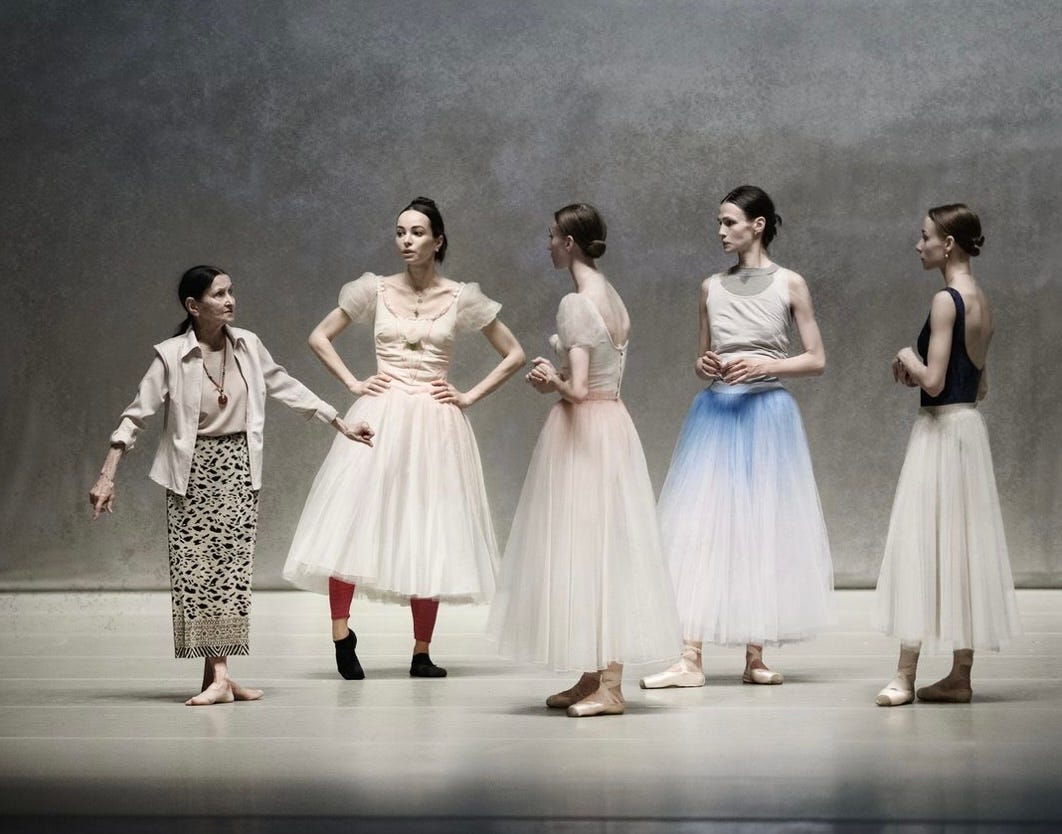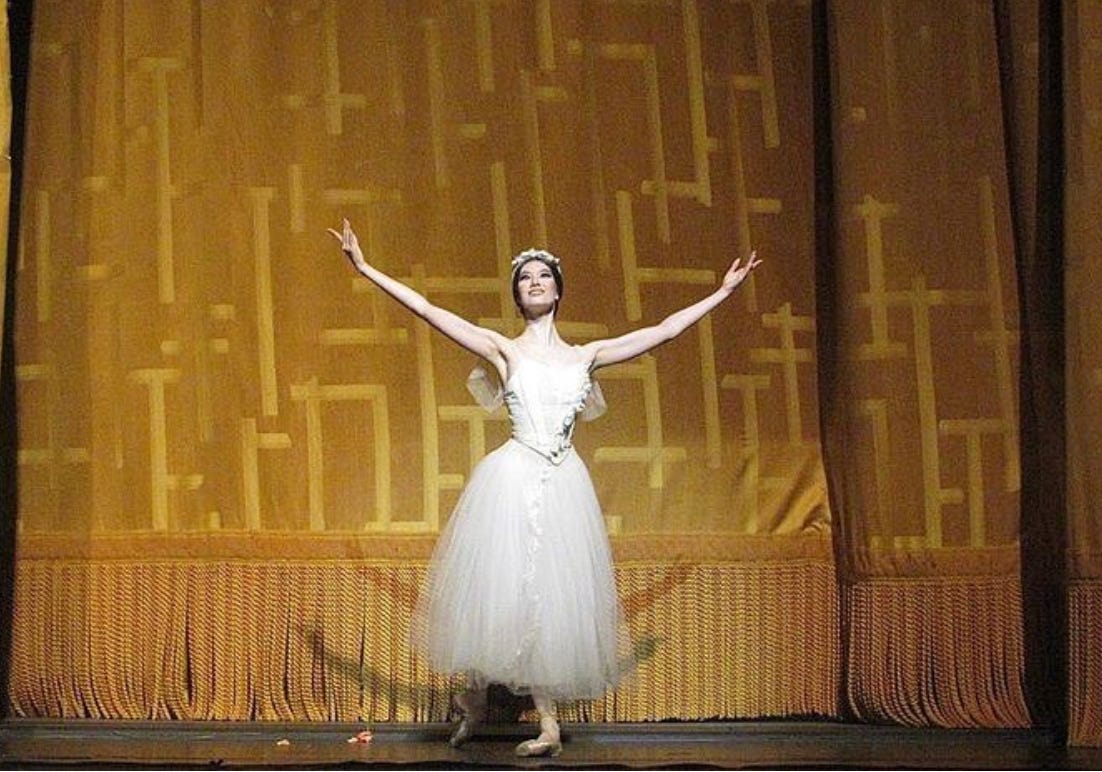In this edition:
-A Review: Olga Smirnova in Giselle with American Ballet Theater.
-Where Watch Now
Olga Smirnova in Dutch National’s Giselle Photo: Alex Gouliaev
The Review:
American culture is a casual one, in its language, in its sartorial expression, in its treatment of the arts and artists. But when a ballerina like Olga Smirnova is in the house—a dancer that descends from a culture that for centuries has revered and invested in dance as both a high art and a practice worthy of being put even in prosaic public education—the entire theater on and off the stage is elevated.
Smirnova is one of the moment’s biggest international stars. Formerly a Bolshoi Prima, she’s currently a Principal with Dutch National—one of the world’s most forward-thinking companies, who also famously hired Micaela Mabinty DePrince when ABT wouldn’t take her; and Ahmad Judeh, the boy born in a Palestinian refugee camp who honed his own talent in the desert, off of YouTube. She joined the company after very publicly denouncing the war in Ukraine, leaving her position and her country in protest.
A choice she’s been frequently lauded for, while many others have been criticized for not doing the same. As if it isn’t an impossible sacrifice—Smirnova herself has spoken of the difficulties, the culture shock, and the losses she’s suffered in the transition.
She trained with one of the most respected teachers in ballet’s history, Lyudmila Kovaleva. Also the lifelong teacher and mentor to another ballet mega star Diana Vishneva—among others.
Like Vishneva, Smirnova possesses the encompassing Russian back. A back that does not end at the torso, for it is really a spine, an energetic center from which every movement initiates and even once appears finished—the pose arrived at, the angle complete—another extension continues like the tail of a comet.
Lyudmilya Kovaleva, Diana Vishneva, Olga Smirnova, Kristina Shapran, Anastasiya Lukina Photo: Mark Olich
Giselle’s Duality
The ballet Giselle, while not as obviously as Swan Lake, is in a way also a dual role. The ballerina must evolve the character from the first act’s innocent and delighted village girl, to madness—of one whose complete trust in love and the goodness of life has been suddenly lost and a schism created in the mind. To the second act’s mature and unearthly saint, a being whose love transcends human trespasses and betrayals.
Smirnova’s first act is less believable than her second. In most of the first act she’s sweet enough and the excellence of her pedigree highlights the holes in American ballet training. But you don’t quite lose the feeling that you’re watching a great ballerina pretend to be a naive village girl—we begin to be rewarded for our patience in the mad scene.
Smirnova lets her loss of mind be a layered and introverted affair, we are forced to lean forward and listen for her movements—made to feel as if we are eavesdropping on a woman coming undone alone in her cell, and not a performer demanding that we witness her plight.
The second act is the true ballerina role, both the choreography and the character are filled with the grandeur and the humility of an ethereal being who is powerful enough to protect life from demonic underworld creatures, yet delicate enough to exist in the air, gross matter is made immaterial.
Through her unbound steps, her arabesques that extend both inward and outward, she takes us into Giselle’s magnanimous transformation. Smirnova disappears and the archetype of a goddess, ghost, saint swallows the theater.
Olga Smirnova as Giselle. Photo: Ashley Taylor
Leading Men and Haunted Lovers
The dashingly handsome Daniel Camargo played opposite her as the irresponsible and deceitful Loys/Albrecht. A nobleman cosplaying as a villager, Albrecht wins Giselle’s heart and depending on who is dancing, either has genuine feelings for her but is trapped by his social status, or, is a feckless cad forced to face himself when his casual flirtation causes another’s death.
Camargo is an accomplished Principal, whose Albrecht portrayal is coolly privileged, as we imagine an eligible 19th-century bachelor would be. He gave us moments of introspection throughout but it wasn’t until the end that we fully felt his remorse—but feel it we did, in the last few moments before the curtain’s fall, when he is left alone on the stage, to live with the irreconcilable consequences of his deceit.
A Superb Hilarion & the Queen—of the Wilis
Hilarion, ballet’s answer to “nice guys finish last,” also loves Giselle and is a true and honest soul who sniffs Albrecht’s trickery and tries to warn her. Mirroring the unfairness in life, it’s Hilarion, rather than the two-timing Albrecht, who is danced to death by the Wilis.
As we experience the ballet through Giselle’s eyes, Hilarion is often an unlikeable character—an unglamorous suitor sent to rain on our parade, but last night was a different story. Played by the corps de ballet member Joseph Markey, his rugged appeal in both stage presence and technique filled the stage.
His Hilarion was honest, fiery and convincing. His onstage chemistry with Smirnova was felt, his entrance caused a silence in the audience. I was surprised to check the program and see that he’s still in the corps.
Myrtha, Queen of the Wilis, was played by Principal Dancer Chloe Misseldine. Wilis are the spirits of betrayed women who died before their wedding day. They rise each night to dance men—foolish enough to walk through the forest at night—to their death.
Misseldine is a gifted beauty, with a face that is seen in the rafters and a loyalty to the drama in her character. She is early in her career and like all young artists, still growing into who she is meant to be.
If we look at a young Vishneva, Yuan Yuan Tan, Lopatkina even, they were also young principals, but their early career versions are incomparable to their fully actualized selves. Often times a young dancer’s technique outpaces their artistry and it is the latter that takes time to catch up to the former.
With Misseldine however, we see her ballerina’s charisma and dramatic depth right away. Her Myrtha was not played as a one-dimensional she-zombie, but we felt her as a woman whose vulnerability was calloused over by the scars of betrayal. Her glint of innocence peeking through, but there was no question what choices her hardened soul would make—a nuance that we would normally only see in the most seasoned artists.
Seeing her next to Smirnova, a ballerina solidly in her prime, it’s clear what we have to look forward to.
Chloe Misseldine at Curtain Call as Myrtha
The Peasant Pas and Corps de Standouts
Jake Roxander was playfully thrilling in the Peasant Pas de Deux. Today spectacular technique is par for the course, but Roxander makes it feel like a surprise, perhaps even to himself.
His every entrance is fresh—charmingly aggressive. He approaches his jumps with the glee of a teenager hurling themselves into the lake and it’s infectious—one hopes to get to see him more and in major roles.
Noticeable again from the corps de ballet was the bubbling Elizabeth Beyer in the first act, and a haunting Sierra Armstrong as Zulma, a solo Wili in the second act. Armstrong made the audience breathe with her; she extended her movements á la Smirnova—her arms and arabesques (when the leg is lifted in the back) hung in the air like the trail of a musical note—not an easy thing to do when pinned to the confines of matching the other dancers onstage.
Giselle in the Human Condition
Giselle is one of ballet’s oldest classics. A Romantic-era ballet (although most versions we see today are based off classical-era choreographer Marius Petipa’s staging), it is replete with truly antiquated nobles, hunting parties, and a few too many peasant dances that don’t move the narrative forward.
But its second act is a pearl in the classical canon. A masterpiece whose choreography—unlike some of the classics—remains largely true to the original, and you can see why the centuries would leave it untouched.
We enter the beauty of its patterning through the archetype of redemption and forgiveness. We have all been Giselle: felt a love that doesn’t recognize the line between the lover and the loved; Hilarion: illogically rejected by our heart’s desire; Myrtha: understandably vengeful; and Albrecht: carelessly duplicitous.
It’s these universal themes in the human experience that will keep this ballet relevant through the next 200 years.
Marianela Nuñez as Giselle Courtesy of Marquee TV
Where to watch?
A huge problem with ballet is that oftentimes it’s impossible to see a show and logistically and financially prohibitive to see many of the world’s greatest dancers.
Even if you live in a major city, most dancers aren’t flying around the world performing all the time. For the most part in order to see a Royal Ballet star you have to go to London, or a NYC Ballet star to NY etc. Insult to injury, very few ballet companies offer meaningful digital access. Enter my favorite streaming platform MARQUEE TV. The have the best classical and contemporary dance library, I use them for myself and my students. In keeping with this edition’s theme, they have Royal Ballet’s Giselle with Marianela Nuñez AND Akram Khan’s Giselle on English National Ballet with Tamara Rojo who originated the role.
Subscribe here and if you find a favorite dancer or ballet, or have any questions about anything send me a line! I read everything!

















Share this post